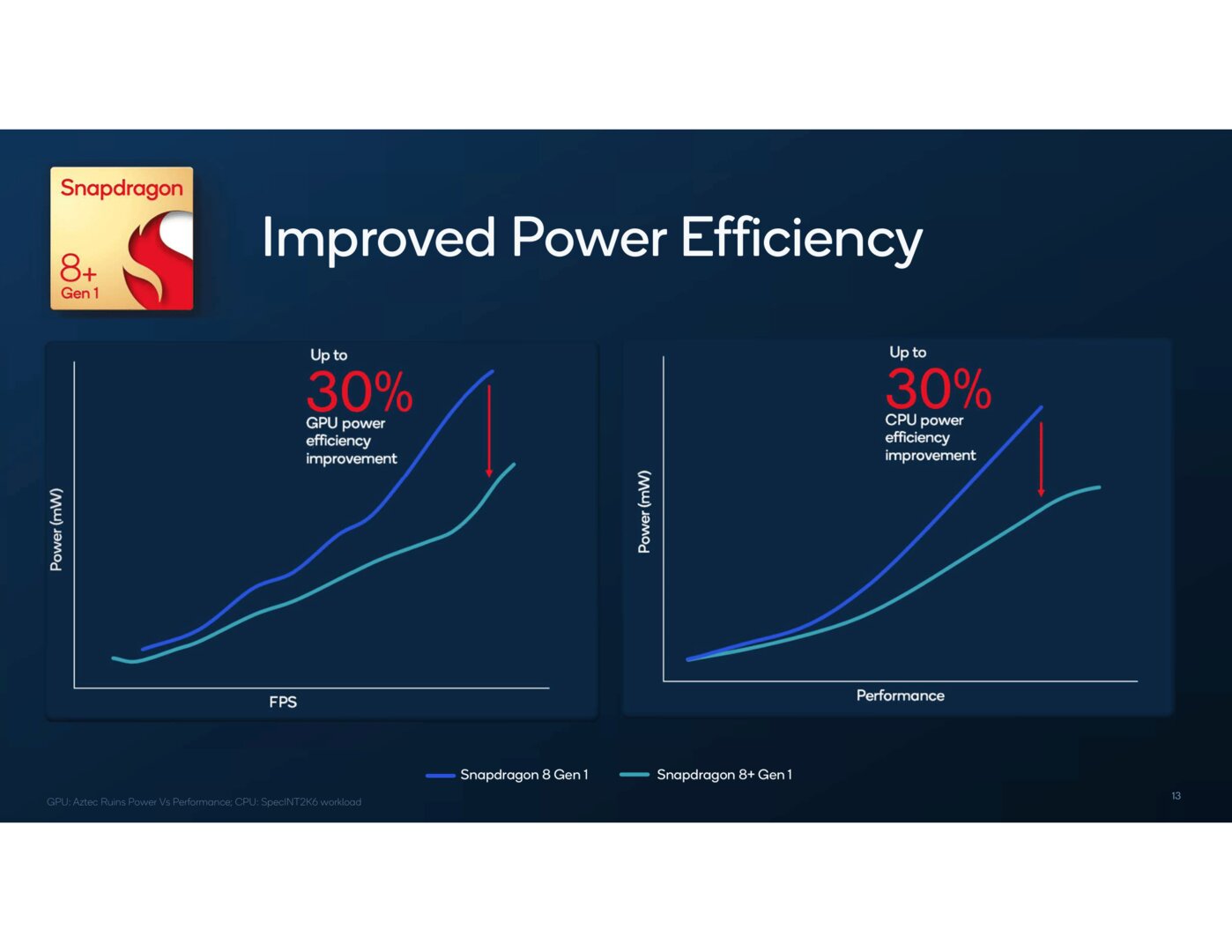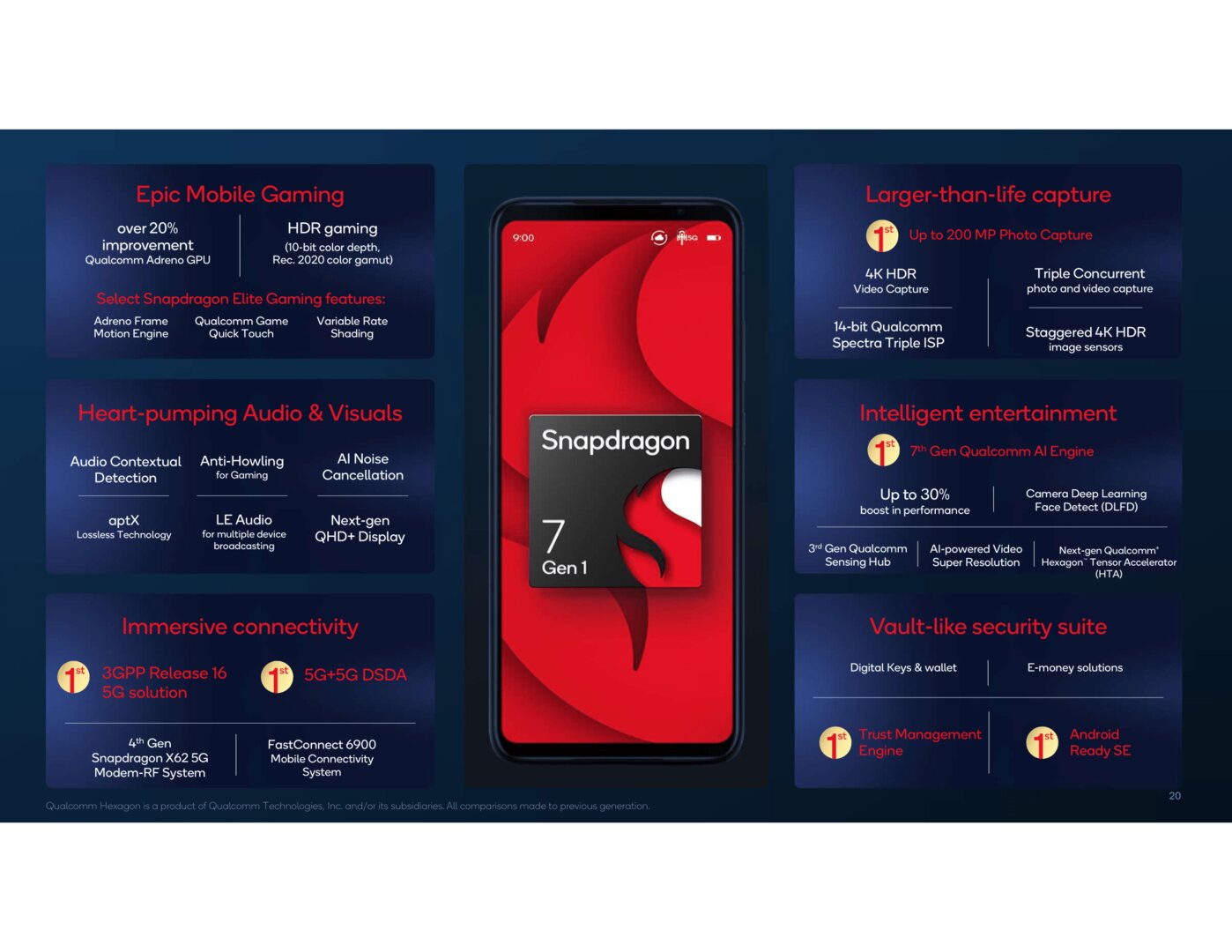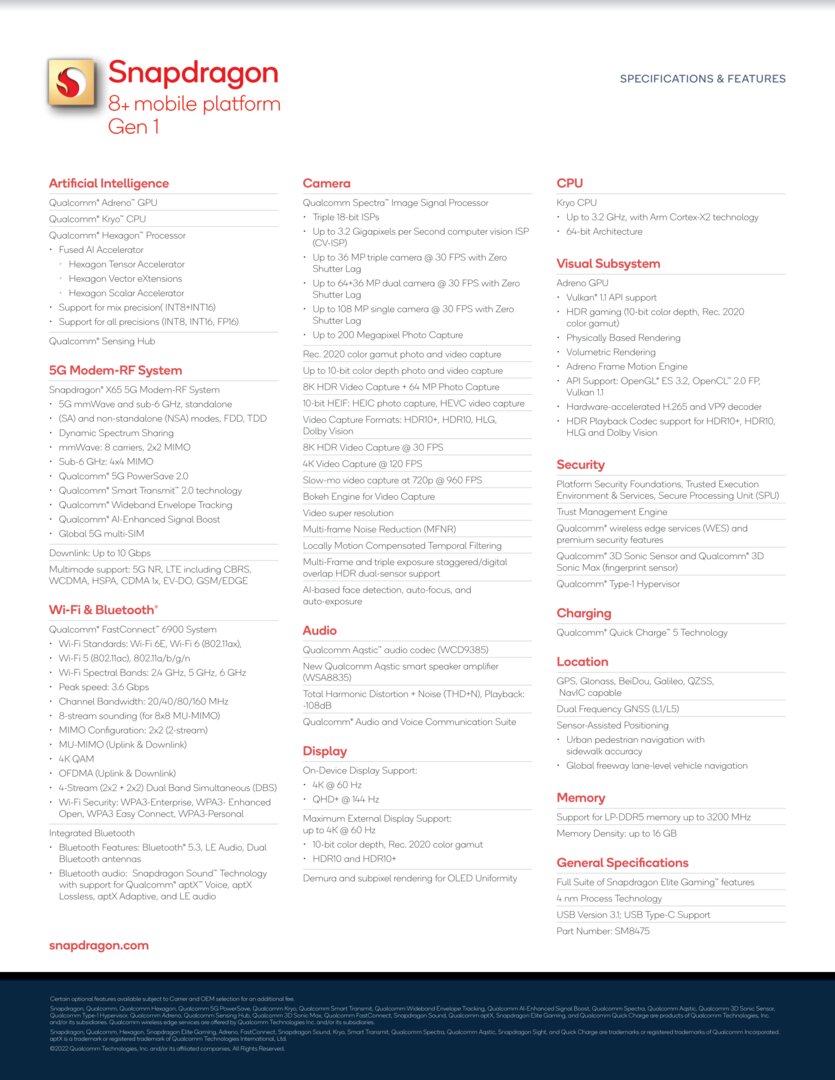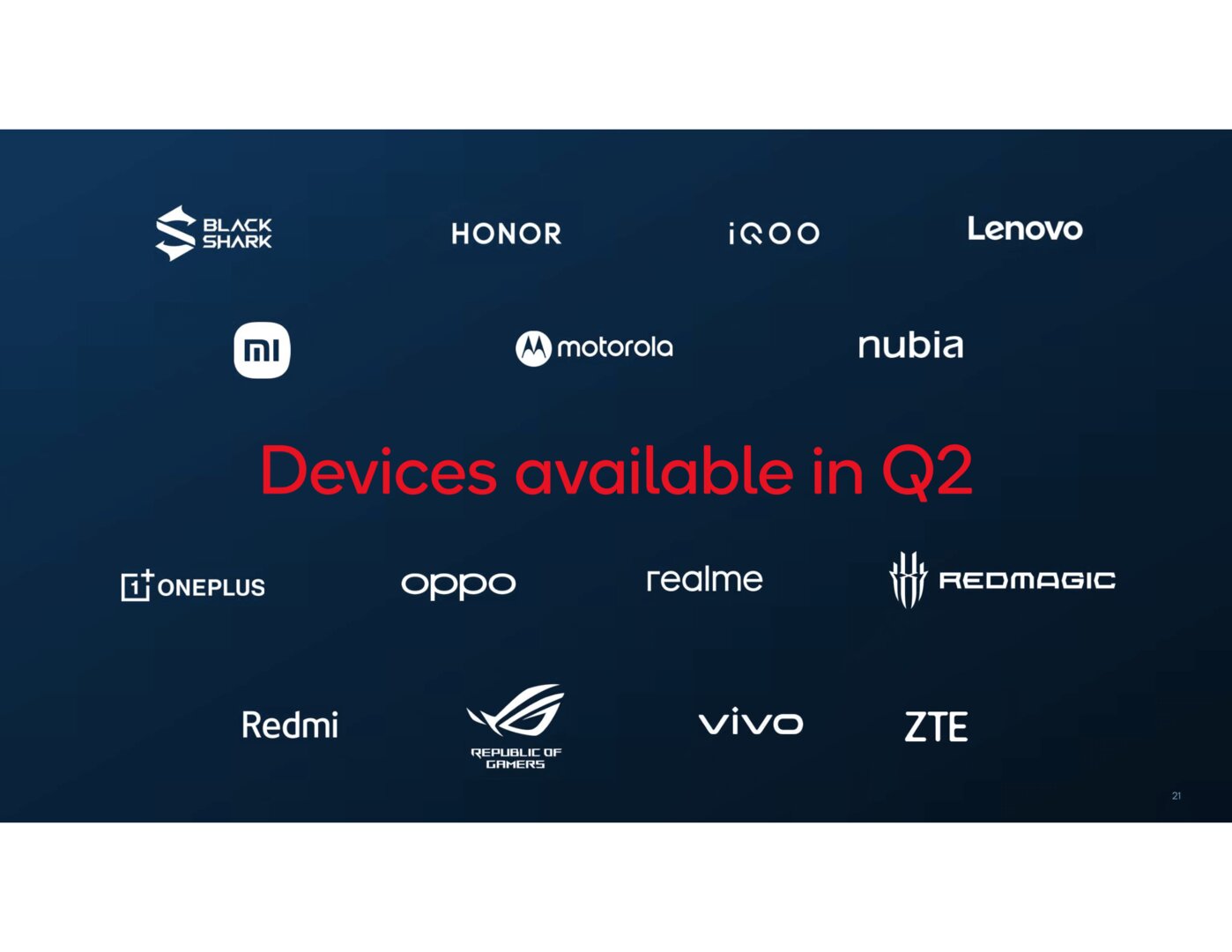With the Snapdragon 8+ Gen 1, Qualcomm is beefing up the Snapdragon 8 Gen 1 smartphone SoC top model. There are no differences in the range of functions, but the clock rates increase and the consumption decreases. The “4 nm process” remains, but it now comes from TSMC and no longer from Samsung. The Snapdragon 7 Gen 1 is brand new.
Thanks to TSMC N4 1.0: 10 percent more clock for CPU and GPU
The Snapdragon 8+ Gen 1 still has a CPU cluster with a Cortex-X2, three Cortex-A170 and four Cortex-A510, but the cores clock higher: The big one can clock up to 3.2 GHz instead of the previous 3.0 GHz Reach the core, Qualcomm still owed the clock rates for the smaller ones in the run-up to the presentation. The GPU, which is still simply referred to as “Adreno” without an identifier, is said to be able to run 10 percent higher clock rates.
Compared to the tests that the editors carried out with the Snapdragon 8 Gen 1 in December 2021, the results of the Snapgradeon 8+ Gen 1 presented by Qualcomm are almost 10 percent higher.
Charts
- Geekbench 5.1 – Multi-Core Total
- Geekbench 5.1 – Single-Core Total
- JetStream 2
- GFXBench Offscreen – Manhattan 1080p (Metal/OpenGL ES 3.1)
23 Entries Geekbench 5.1 – Multi-Core Total
-
- < li class="chart__row chart__row--hidden toggle-body-item nojs-tr">Apple M1 Pro12.550
- Apple M17 .280
- Apple A15 Bionic (5 Core GPU)4,693
- Apple A15 Bionic (4 Core GPU)4,680
- Apple A14 Bionic4.279
- Snapdragon 8+ Gen 14.150
- Snapdragon 8 Gen 13,839
- Qualcomm Snapdragon 888 (1)3,700
- Qualcomm Snapdragon 888 (2)3,699
- Samsung Exynos 2200 (S22 Ultra)3,667
- Samsung Exynos 2200 (S22+)3.466
- Apple A13 Bionic3.431
- Qualcomm Snapdragon 865 (2)3.423
- HiSilicon Kirin 90003.396
- Samsung Exynos 21003.371
- Qualcomm Snapdragon 865 (1)3,191
- HiSilicon Kirin 990 (2)2,970
- Google Tensor2,934
- Samsung Exynos 990 (1)2,827
- Samsung Exynos 990 (2)2.819
- Qualcomm Snapdragon 8cx Gen 12.761
- MediaTek Dimensity 12002.576
- Qualcomm Snapdragon 765G (1)1.953
- Qualcomm Snapdragon 720G1.912
- Qualcomm Snapdragon 4801.685
- Qualcomm Snapdragon 765G (2)1,613
- Qualcomm Snapdragon 765G (3)1,581
-
- Apple M1 Pro1,774
- Apple A15 Bionic (4 Core GPU)1,740
- Apple A15 Bionic (5 Core GPU)1,737
- Apple M11,721
< li class="chart__row chart__row--hidden toggle-body-item nojs-tr">Apple A14 Bionic1.608
- Apple A13 Bionic1.329
- Snapdragon 8+ Gen 11,320
- Snapdragon 8 Gen 11,237
- Samsung Exynos 2200 (S22+)1,178
- Qualcomm Snapdragon 888 (1)1.128
- Qualcomm Snapdragon 888 (2)1.126
- Samsung Exynos 21001.102
- Google Tensor1.052
- Qualcomm Snapdragon 8701.032
- Samsung Exynos 990 (2)954
- HiSilicon Kirin 9000944
- Qualcomm Snapdragon 865 (2)914
- Samsung Exynos 990 (1)913
- Qualcomm Snapdragon 865 (1)896
- MediaTek Dimensity 1200801
- HiSilicon Kirin 990 (2)754
- Qualcomm Snapdragon 8cx Gen 1702
- Qualcomm Snapdragon 720G646
- Qualcomm Snapdragon 765G (1)618
- Qualcomm Snapdragon 765G (2)598
- Qualcomm Snapdragon 765G (3)593
- Qualcomm Snapdragon 480507
< li class="chart__row">Samsung Exynos 2200 (S22 Ultra)1,190
Unit: Points 23 items JetStream 2
-
- Apple M1 Pro196.345
- Apple A15 Bionic (5 Core GPU)180.060
- Apple A15 Bionic (4 Core GPU)179,770
- Apple M1177,995
- Snapdragon 8+ Gen 1155.000
- Apple A13 Bionic141.475
- Snapdragon 8 Gen 1137.905
- Qualcomm Snapdragon 888 (2)121.171
- Google Tensor84.201
- Samsung Exynos 210080.932
- Qualcomm Snapdragon 865 (1)72.067
- Samsung Exynos 2200 (S22 Ultra)70.272
- Qualcomm Snapdragon 888 (1)70.074
- Samsung Exynos 2200 (S22+)69.051
- Qualcomm Snapdragon 865 (2)68.410
- Samsung Exynos 990 (2)59.087
- Qualcomm Snapdragon 87058.226
- HiSilicon Kirin 900057.980
- Qualcomm Snapdragon 720G56.680
- HiSilicon Kirin 990 (2)56.262
- Samsung Exynos 990 (1)54.875
- Qualcomm Snapdragon 765G (2)51.741
- Qualcomm Snapdragon 765G (3)51.211
- MediaTek Dimensity 120051.137
- Qualcomm Snapdragon 48048.550
- Qualcomm Snapdragon 8cx Gen 130.482
- Qualcomm Snapdragon 765G (1)17,934
Unit: Points 25 entries GFXBench Offscreen – Manhattan 1080p (Metal/OpenGL ES 3.1)
-
- Apple M1 Pro545,6
- Apple M1271.8
- Snapdragon 8+ Gen 1188.0
- Apple A15 Bionic (5 Core GPU)183.2
- Snapdragon 8 Gen 1175.0
- Apple A15 Bionic (4 Core GPU)153.8
< li class="chart__row chart__row--hidden toggle-body-item nojs-tr">Apple A14 Bionic143,0
- Google Tensor124 ,0
- Qualcomm Snapdragon 888 (1)122,0
- Samsung Exynos 2200 (S22+)122.0
- Apple A13 Bionic121.8
- Samsung Exynos 2200 (S22 Ultra)120.0
- Qualcomm Snapdragon 888 (2)118.0
- Samsung Exynos 2100114.0
- HiSilicon Kirin 9000108, 0
- Qualcomm Snapdragon 87095.0
- Qualcomm Snapdragon 865 (1)89.0
- Qualcomm Snapdragon 865 (2)87.0
- Samsung Exynos 990 (1)86.0
- Samsung Exynos 990 (2)86.0
- Qualcomm Snapdragon 855+81.0
- MediaTek Dimensity 120078.0
- Samsung Exynos 982572.0
- HiSilicon Kirin 990 (2)70.0
- HiSilicon Kirin 990 (1)67, 0
- Qualcomm Snapdragon 765G (1)38.0
- Qualcomm Snapdragon 720G33.0
- Qualcomm Snapdragon 48029.0
- Qualcomm Snapdragon 765G (3) 22.0
Unit: frames per second (FPS)
But the real figurehead of the 8+ Gen 1 is actually something else: the power consumption.
Thanks to TSMC N4 2.0: Same performance with 30 percent less consumption
According to Qualcomm, the new SoC achieves the same CPU and GPU performance as its predecessor while consuming 30 percent less power. With the new higher clock rates, the advantage is a bit smaller in absolute terms, but it is still considerable. Overall, Qualcomm speaks of a 15 percent reduction in power consumption for the SoC.



The new Qualcomm Snapdragon 8+ Gen 1 from TSMC's N4 production (Image: Qualcomm)
The reason is to be found in the change in production: Although a 4 nm process remains, the Snapdragon 8+ Gen 1 is being manufactured for the first time by TSMC and not Samsung. For months there have been reports that Qualcomm could consider a complete switch from Samsung to TSMC because the yield at Samsung is very poor – Samsung was even accused of having embellished quarterly reports in this context. With the Snapdragon 8+ Gen 1, the first step is now done.
The partnership with Samsung is said to have had serious consequences for Qualcomm. For example, competitor MediaTek overtook Qualcomm in terms of quantities in 2021, with the higher chip yield due to production at TSMC being a key influencing factor. And at the end of 2021, MediaTek announced the production of the Dimensity 9000 at TSMC in the N4 process.
1 × Cortex-X2 @ 3.2xx GHz
3 × Cortex-A710 @ ? GHz
4 × Cortex-A510 @ ? GHz “Kryo CPU”
1 × Cortex-X2 @ 2.995 GHz
3 × Cortex-A710 @ 2.50 GHz
4 × Cortex-A510 @ 1.80GHz 1 × Kryo 680 Prime
(Cortex-X1) @ 2.995GHz
1 × 1MB L2
3 × Kryo 680 Gold
(Cortex -A78) @ 2.40GHz
3 × 512KB L2
4 × Kryo 680 Silver
(Cortex-A55) @ 1.80GHz
4 × 128KB L2 1× Kryo 680 Prime
(Cortex-X1) @ 2.84GHz
1 × 1MB L2
3 × Kryo 680 Gold
(Cortex-A78) @ 2.40GHz
3 × 512KB L2
4 × Kryo 680 Silver
(Cortex-A55) @ 1.80GHz
4 × 128 KB L2 GPU “Adreno GPU” + 10 percent clock “Adreno GPU” Adreno 660 @ 840 MHz Memory LPDDR5 @ 3,200 MHz LPDDR5 @ 3,200 MHz
LPDDR4X @ 2,133 MHz ISP “Spectra ISP”
Triple 18 bit ISP
3.2 GP/s
1 × 200 MP Photo
3 × 36 MP @ 30 FPS ZSL
1 × 64 MP/1 × 36 MP @ 30 FPS ZSL
1 × 108MP @ 30FPS ZSL
10-bit HDR/Rec. 2020 photo + video
8K HDR video + 64 MP photo
4K video @ 120 FPS
8K HDR video @ 30 FPS
720p video @ 960 FPS
HDR10(+), HLG, Dolby Vision Spectra 580
Triple 14 bit ISP
2.7 GP/s
1 × 200 MP photo
3 × 28 MP @ 30 FPS ZSL
1×64MP/1×25MP@30FPS ZSL
1×84MP@30FPS ZSL
10-bit HDR/Rec. 2020 photo + video
4K video + 64 MP photo
4K video @ 120 FPS
8K video @ 30 FPS
720p video @ 960 FPS
HDR10(+), HLG, Dolby Vision AI 7th Gen AI Engine
?? TOPS
(CPU + GPU + Hexagon DSP) 6th Gen AI Engine
32 TOPS
(CPU + GPU + Hexagon 780 DSP) 6th Gen AI Engine
26 TOPS
(CPU + GPU + Hexagon 780 DSP) Modem Snapdragon X65 Snapdragon X60
The CEO's visit to Samsung today, Friday, shows the current political issue surrounding production at Qualcomm. The Snapdragon 8+ Gen 1 should serve as a solid argument for Qualcomm in negotiations with Samsung. But a higher yield cannot be forced.
However, switching to TSMC is not a trivial undertaking either: TSMC can hardly save itself from orders and the 4 nm process from Taiwan is said to be significantly more expensive than that from South Korea. No wonder that the second new product of the day comes from Samsung.
Snapdragon 7 Gen 1
Parallel to the Snapdragon 8+ Gen 1, Qualcomm is also introducing a completely new SoC with the Snapdragon 7 Gen 1. After the 8(+) Gen 1, it is the second SoC in the new naming scheme. This SoC is also manufactured in 4 nm – but still by Samsung.
Image 1 of 3
 The new Qualcomm Snapdragon 7 Gen 1 comes in 4 nm from Samsung
The new Qualcomm Snapdragon 7 Gen 1 comes in 4 nm from Samsung  The new Qualcomm Snapdragon 7 Gen 1 comes in 4 nm from Samsung
The new Qualcomm Snapdragon 7 Gen 1 comes in 4 nm from Samsung  The new Qualcomm Snapdragon 7 Gen 1 comes in 4 nm from Samsung
The new Qualcomm Snapdragon 7 Gen 1 comes in 4 nm from Samsung
The Snapdragon 7 Gen 1 offers three major innovations over its predecessors in the 7xxG series: it inherits the 7th generation of the AI engine from the 8 series, gets a 14-bit Spectra ISP for photos up to 200 MP, and offers Qualcomms new Secure Enclave. The clock remains at a maximum of 2.4 GHz as with the predecessor Snapdragon 780G, but the cores are new (ARMv9) – Qualcomm has not yet said exactly which combination is used and the data sheet does not provide this information either.
 Snapdragon 8+ Gen 1 data sheet (Image: Qualcomm)
Snapdragon 8+ Gen 1 data sheet (Image: Qualcomm)Recently there were rumors of four Cortex-A710 and four Cortex-A510 and a GPU dated Type Adreno 662, which could be a further development of the Adreno 660 from the Snapdragon 888.
Numerous OEMs are planning the first end devices with Snapdragon in the second quarter and thus by the end of June 7 Gen 1.
 The new one Qualcomm Snapdragon 7 Gen 1 is still coming from Samsung in 4 nm (Picture: Qualcomm)
The new one Qualcomm Snapdragon 7 Gen 1 is still coming from Samsung in 4 nm (Picture: Qualcomm) ComputerBase has received information about this article from Qualcomm under NDA. The only requirement was the earliest possible publication date.